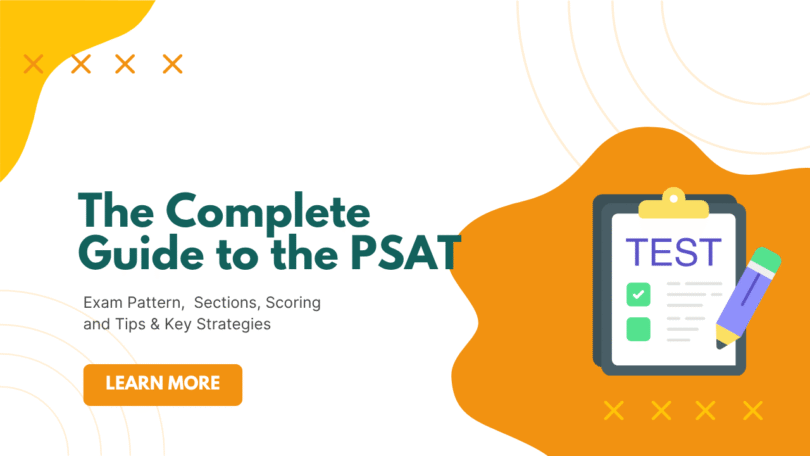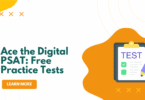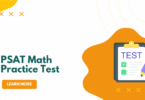The PSAT/NMSQT (Preliminary SAT/National Merit Scholarship Qualifying Test) is the official practice test for the SAT, taken by millions of high school students, usually in the 10th (sophomore) and 11th (junior) grades.
It serves two primary functions: it measures your college readiness and acts as the entry exam for the prestigious National Merit Scholarship Program.
1. What’s on the Digital PSAT? (The Structure)
The PSAT is now a fully digital and adaptive test, meaning it is taken on a computer or tablet, and the difficulty of the second part of each section adjusts based on how well you perform on the first part.
The total testing time is 2 hours and 14 minutes (134 minutes) with a total of 98 questions.
| Section | Total Time | Total Questions | Format (Adaptive) | What It Measures |
| Reading and Writing | 64 minutes (Two 32-min Modules) | 54 questions | Short passages (each with one question) testing grammar, vocabulary in context, and comprehension. | Your ability to analyze and edit text from a range of academic subjects. |
| Math | 70 minutes (Two 35-min Modules) | 44 questions | A mix of multiple-choice and student-produced answers (grid-ins). A calculator is allowed for all Math questions. | Your mastery of Algebra, Advanced Math, Problem-Solving and Data Analysis, and Geometry/Trigonometry. |
Key Test Features:
- Adaptive Testing: Your performance on the first module of Math determines the difficulty level of your second Math module. The same applies to the Reading and Writing section.
- Time Per Question: You have more time per question than on the old paper-based test, but you must still manage your time efficiently within each module.
- Digital Tools: The testing app (Bluebook) includes a built-in timer, a calculator (for Math), and tools to highlight text and eliminate answer choices.
2. Detailed Section Breakdown and Examples
Reading and Writing Section (54 Questions)
This section measures four key areas: Information and Ideas, Craft and Structure, Expression of Ideas, and Standard English Conventions. Questions are based on short passages (25-150 words).
Example Question (Standard English Conventions)
Passage: In the early 1800s, prospectors flocked to the newly discovered gold fields, risking everything in pursuit of fortune. Gold rushes often led to rapid, uncontrolled town growth and sudden economic booms; however these were often followed by inevitable busts.
Question: Which choice completes the text with the most logical and precise transition?
(A) consequently
(B) furthermore
(C) however
(D) for example
Correct Answer: (C) however (This tests your ability to select the transitional word that logically connects two contrasting ideas: rapid booms vs. inevitable busts.)
Example Question (Words in Context)
Passage: Composer Clara Schumann was a central figure in the Romantic era, yet her contributions were long overshadowed by her husband’s career. Her reputation, however, has recently been reclaimed by modern musicologists who emphasize her technical brilliance and emotional depth.
Question: As used in the text, what does the word “reclaimed” most nearly mean?
(A) taken back
(B) protested
(C) celebrated
(D) restored to prominence
Correct Answer: (D) restored to prominence (The context suggests her reputation was revived or brought back to a high position.)
Example Question (Information and Ideas)
Passage: Though the majority of Mars’s surface is too cold to support liquid water, orbital data confirms the presence of permafrost and vast deposits of water ice beneath the surface, suggesting that if the planet’s atmospheric pressure were higher, water might flow freely.
Question: The primary purpose of the text is to:
(A) argue that Mars once had flowing water on its surface.
(B) present evidence that challenges the findings of orbital data.
(C) discuss the potential for liquid water on Mars given certain conditions.
(D) describe the composition of Mars’s atmospheric pressure.
Correct Answer: (C) discuss the potential for liquid water on Mars given certain conditions (The text focuses on the current state of ice and the condition (higher atmospheric pressure) under which water might flow.)
Math Section (44 Questions)
The Math section covers four main content domains: Algebra, Advanced Math, Problem Solving and Data Analysis, and Geometry/Trigonometry.
Example Question (Algebra)
Question: If $2x – 3 = 17$, what is the value of $x + 5$?
(A) 8
(B) 10
(C) 15
(D) 20
Solution Method: First solve for $x$ ($2x = 20$, so $x=10$). Then substitute $x$ into the expression $x+5$, which equals $10+5=15$.
Correct Answer: (C) 15
Example Question (Problem Solving and Data Analysis)
Question: A local bakery recorded that 40% of the cakes sold last week were chocolate, and 25% of the remaining cakes were vanilla. If 60 total cakes were sold, how many vanilla cakes were sold?
(A) 9
(B) 15
(C) 24
(D) 36
Solution Method: If 40% were chocolate, 60% remained (0.60 * 60 = 36 cakes). 25% of the remainder were vanilla (0.25 * 36 = 9 cakes).
Correct Answer: (A) 9
Example Question (Geometry)
Question: In the $xy$-plane, a circle has a center at $(3, 5)$ and a radius of 4. Which of the following is an equation of the circle?
(A) $(x-3)^2 + (y-5)^2 = 4$
(B) $(x+3)^2 + (y+5)^2 = 4$
(C) $(x-3)^2 + (y-5)^2 = 16$
(D) $(x+3)^2 + (y+5)^2 = 16$
Solution Method: The standard equation for a circle is $(x-h)^2 + (y-k)^2 = r^2$, where $(h, k)$ is the center and $r$ is the radius. Substituting $h=3$, $k=5$, and $r=4$ gives $(x-3)^2 + (y-5)^2 = 4^2 = 16$.
Correct Answer: (C) $(x-3)^2 + (y-5)^2 = 16$
3. PSAT Scoring and The National Merit Scholarship
Your score is based purely on the number of questions you answer correctly—there is no penalty for guessing or incorrect answers. Therefore, you should always answer every question before time runs out!
Score Range:
- Section Scores: Each section (Reading & Writing, and Math) is scored from 160 to 760.
- Total Score: Your final PSAT score ranges from 320 to 1520.
The National Merit Factor (For 11th Graders)
The most significant benefit of the PSAT is that it serves as the National Merit Scholarship Qualifying Test (NMSQT). This is a competition for academic recognition and scholarships.
- Selection Index: The National Merit Scholarship Corporation (NMSC) uses a special Selection Index score, calculated by combining your Reading, Writing, and Math test scores and multiplying the sum by two.
- Qualifying: Only 11th-grade scores count for the competition. Approximately 50,000 students nationwide qualify for initial recognition, with a smaller group progressing to Semifinalist status (the highest scorers in each state).
- The Benefit: Achieving Semifinalist or Finalist status can lead to scholarship money and is a prestigious academic honor that looks excellent on college applications.
4. Top Benefits and Preparation Tips
Why Take the PSAT?
- SAT Practice: It is the best warm-up for the SAT, familiarizing you with the format, timing, and digital interface (the same Bluebook app is used for both).
- Academic Feedback: Your score report breaks down your performance into specific subscores (like “Command of Evidence” or “Passport to Advanced Math”), showing you exactly where you need to focus your study time for the SAT.
- College Connections: The College Board uses your scores (with your permission) to connect you with colleges and scholarship organizations actively looking for students like you.
Essential Preparation Tip:
Since there is no guessing penalty, focus on Triage. Work through the easy questions first to secure those points, mark the harder ones for review, and ensure you have an answer filled in for every single question before the module timer expires.
The video below offers valuable study resources and preparation tips for the PSAT. All About the PSAT Test




